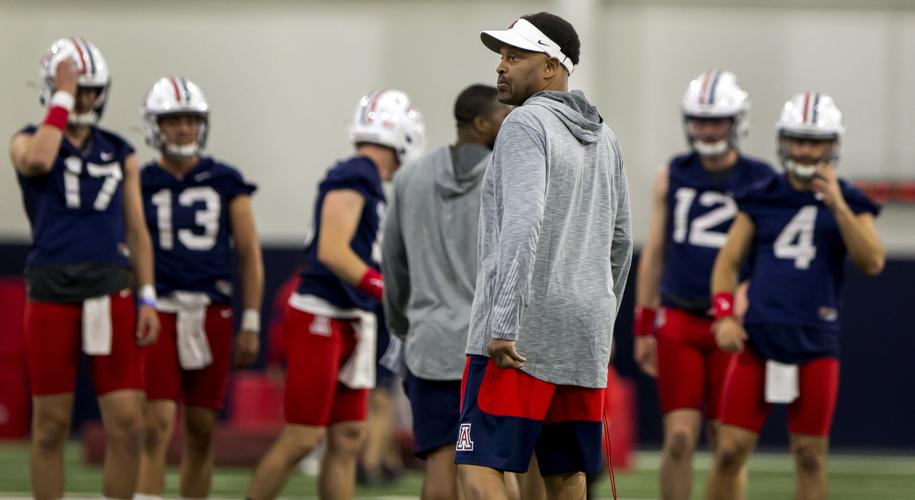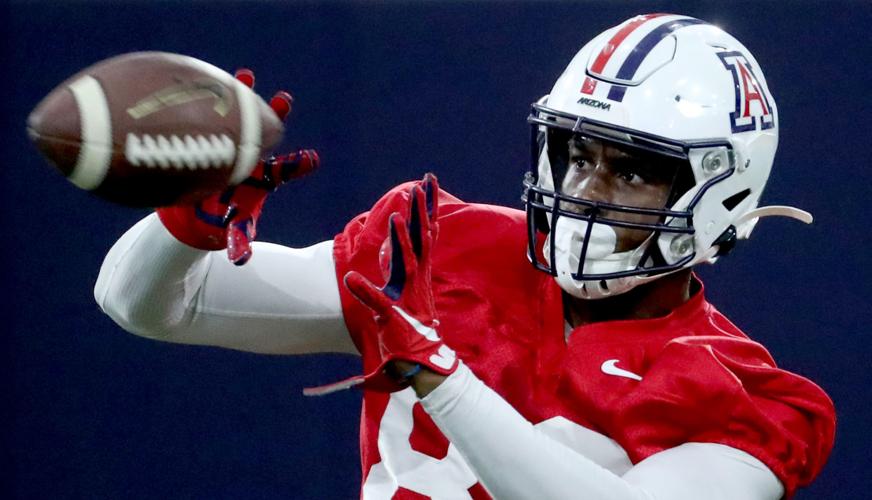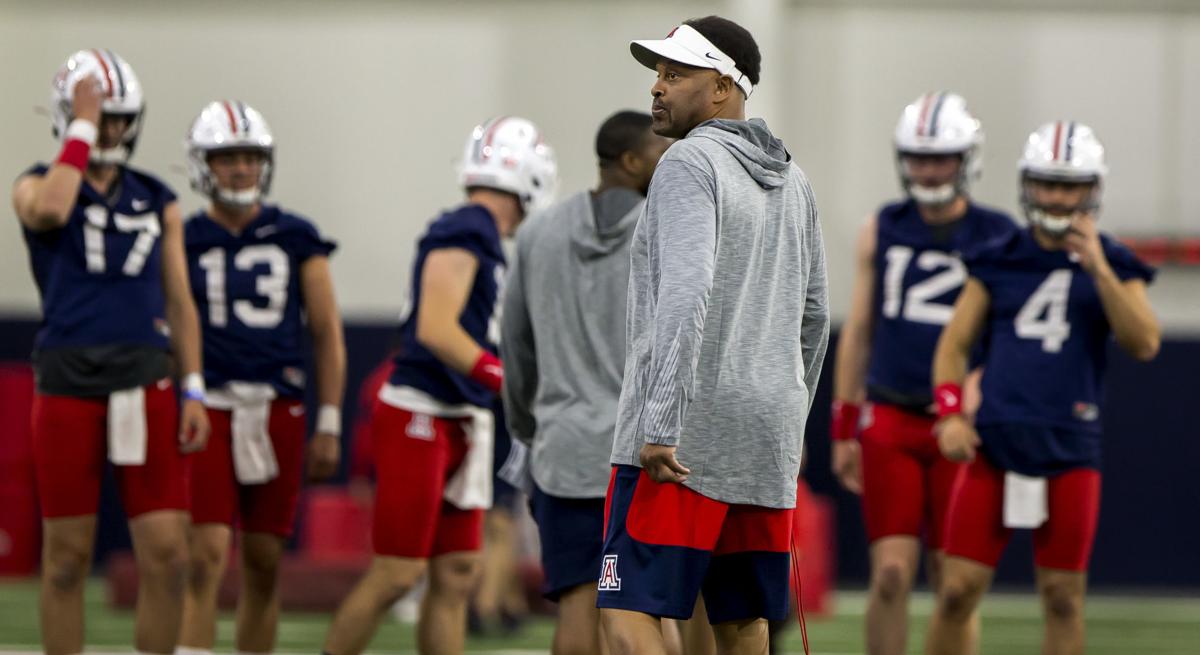The Arizona Wildcats are following the lead of the Pac-12 Conference by bringing student-athletes back to campus in mid-June.
The UA “will begin the process of having student-athletes return to campus for volunteer physical training” on June 15, the school announced Friday morning. That date coincides with the league’s recommendation issued earlier this week. Campuses have been closed to students since mid-March because of the coronavirus pandemic.
The first group will consist of football players. Student-athletes from other sports, along with select staff members, will return “in phases on a weekly basis” thereafter, the school said in a news release. Priority will go to those who compete in fall sports. The release also noted that “all student-athletes and staff members on campus will follow significantly elevated safety protocols for testing, tracing and treatment.”
“The phased reentry of student-athletes is the next step in Arizona Athletics’ commitment to a safe and healthy return to campus,” UA athletic director Dave Heeke said, via the school. “This comprehensive plan to bring student-athletes back to campus is a collaboration between our athletics department and campus partners to develop guidelines, protocols and procedures.
“I want to thank President (Robert C.) Robbins and university leadership for their guidance and vision for bringing Wildcats back to campus. There are many factors that remain beyond our control, and our athletics department will still face some uncertainty before completely reopening. However, our intent remains a return to competition.”
The football program has been discussing contingencies for bringing the squad back to campus and launching in-person workouts since the pandemic shut down spring practice in mid-March. The go-ahead was given Thursday night.
The first group will consist of 20-23 players who are from Tucson or remained in town when spring sports were halted. A slightly bigger group is expected to come the following week. Weightlifting groups will be smaller to allow for physical distancing.
Although none of Arizona’s specific policies have been finalized, student-athletes will be expected to wear university-issued masks whenever possible. Some football players already have begun to wear masks and gloves when working out in their hometowns. Coaches also have been told to expect to wear masks, among other procedural changes.
In conjunction with the university and the athletic department, the football program is working to put in place and communicate clear guidelines and procedures before June 15.
Workouts are voluntary, and student-athletes’ families have been told they don’t have to send their children back to campus if they feel uncomfortable about the prospect. The “vast majority” of football players and their families support the idea of returning to campus and commencing workouts, one program source said.
Football workouts usually would begin in early June, so the June 15 start date isn’t too far afield. June 8 is the start of the first summer-school session and normally would bring the first wave of freshmen who didn’t enroll in January. That won’t happen this year.
Incoming freshmen who have graduated from high school are allowed to participate in virtual meetings with their soon-to-be teammates and coaches. The second summer session begins July 6 and is considered a hoped-for target date for the arrival of the 2020 freshman class.
Training camp typically begins about a month before the start of the season. Arizona is scheduled to open the ’20 campaign on Aug. 29 at home vs. Hawaii.

Arizona Wildcats tight end Zach Williams gets his hands on a throw during day two of spring practice at Lowell-Stevens, March 3, 2020, Tucson, Ariz.
Robbins and Heeke have mentioned the idea of a “hybrid model” for fall-semester attendance featuring a combination of in-person and online instruction. Classes are exclusively online for the time being.
Some football coaches have been operating out of their offices at the Lowell-Stevens Football Facility on a part-time basis while following distancing and safety protocols, such as wearing masks while in public areas. Team meetings are taking place regularly but only via video-chat software.
One athletic-department insider described the overall undertaking as a “massive, evolving plan.” One of the complications the UA and other institutions face is controlling the activities of student-athletes who live off campus. Workouts take up only a fraction of each day. Coaches have been emphasizing to their players the importance of acting responsibly during this crisis.
The other fall sports are soccer, volleyball and cross-country. (Golf and other sports have workouts and events during the fall semester but aren’t categorized as fall sports.) All have rosters that are significantly smaller than football; soccer, for example, currently lists 21 players on its online roster. All three sports started their seasons in late August last year.
The men’s basketball team is tentatively expecting players back in July, while the women’s basketball team’s return date is still unsure, according to staffers.
The athletic department’s Reentry Planning Team has been working in conjunction with the university’s Reentry Task Force on a phased plan to bring back students that follows conference, NCAA and governmental guidelines.
The Pac-12 announced Tuesday that it would allow for voluntary workouts to begin June 15 at the discretion of each member campus. Utah on Thursday revealed a plan for the “phased return” of student-athletes, also starting June 15.
The Pac-12 also released an extensive set of guidelines and protocols for returning to campus, including seven-day isolation for those flying in from out of town, required face coverings and regular temperature checks.
The NCAA on Friday released “action plan considerations” for the “resocialization of collegiate sport.”
The 3,263-word document was developed in consultation with the NCAA COVID-19 Advisory Panel and includes recommendations for personal behavior (physical distancing, mask wearing, hand hygiene) and institutional protocols (screening, contact tracing, isolation/quarantine if necessary).
“The decision to reopen college campuses and resume sport … is not binary in nature,” the document states. “Rather, it involves a complex combination of objectives that speak to decreasing harm, maximizing the number of lives saved and improving overall quality of life for American citizens. A successful balancing of these objectives will most likely involve the development of targeted strategies that are based on emerging COVID-19 data and information.”






